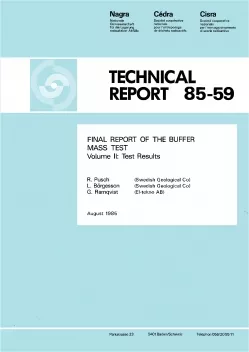
Technical Report NTB 85-59
Final report of the buffer mass testVolume II: Test Results
The evaluation of the Buffer Mass Test mainly concerned the heating of the bentonite/rock system that simulated hot canisters in deposition holes, the swelling and swelling pressures of the expanding bentonite in the heater holes, and the water uptake of the bentonite in the holes as well as in the tunnel backfill. These processes had been predicted on the basis of laboratory-derived data and FEM calculations with due consideration of the actual geometry.
The recorded temperatures of the bentonite and surrounding rock were found to be below the maximum temperature that had been set, but higher than the expected values in the initial period of testing. The heater surface temperatures dropped in the course of the tests due to the uptake of water from the rock even in the "driest" hole which was located in almost fracture-free rock.
The water uptake in the highly compacted bentonite in the heater holes was manifested by a successively increased swelling pressure at the bentonite/rock interface. It was rather uniformly distributed over this interface and reached a maximum value of about 10 MPa.
The water content determination confirmed that water had been absorbed by the bentonite from the rock even in the driest holes where the counteracting thermal gradient was rather high. In the wettest holes the saturation became almost complete and a high degree of saturation was also observed in the tunnel backfill. Both in the heater holes and the tunnel, the moistening was found to be very uniform along the periphery, which is at least partly explained by the self-sealing ability of bentonitic buffer materials.
A general conclusion is that the involved physical processes are well understood and that the ultimate physical state of the buffer materials under repository conditions can be safely predicted.
